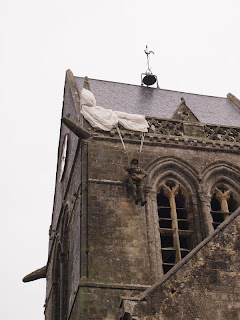After a jam packed day on Friday, the Duckloe clan was up early on Saturday morning to drive to St. Mere Eglise to start our tour of the American D-Day beaches. We met up with Elwood Von Siebold (je dis la verite, that was his name. I did not ask if he had his name tattooed on his knuckles like Elwood Blues), a British Expat and a "D-Day zealot" according to Rick Steves(the all knowing guidebook master).
The house of our tour guide, also the landing site of one American paratrooper on D-Day
Mere St. Eglise church, site where Paratrooper John Steele "landed"
Statue commemorating John Steele's landing on the church. However according to Elwood, his parachute got caught on the other side, it would have been green, and the uniform is wrong. Ah well.
Inside the church
Stained Glass Window depicting the Virgin Mary and Paratroopers (built in the 1960's)
St. Michael, Patron Saint of paratroopers. The paratroopers were integral in liberating the town, and defending the U.S flank for the D-Day invasion
Museum at Mere St. Eglise
C-47 Plane to transport Paratroopers across the English Channel. The planes could not fly too low or too fast or else the troopers would not have enough time to deploy their parachutes or they would miss the drop zone. This made the planes easy targets for Nazi Anti-Aircraft fire.
Glider used to transport supplies and men. There are only 3 original WWII gliders left.
Statue commemorating the liberation of St. Mere Eglise. The shackles around the hands are breaking.
Outside the Utah Beach Museum. The "hedgehogs" were installed by Nazis to prevent boats from landing on the beaches.
The draw (gap) at Utah Beach, where soldiers, supplies, and vehicles entered enemy territory. The Americans had claimed the beach by mid morning on June 6th.
Elwood describing the landing at Utah Beach
Pointe du Hoc
U.S Army Rangers had the task of scaling these cliffs and taking out the German guns that defended the cliffs. The guns had been moved, but the rangers found them and destroyed them.
Hole left by the shelling of Pointe du Hoc. The entire point had massive ditches left by the bombs.
Gun Installation
Omaha Beach
The Americans were charged with securing Omaha Beach as well as Utah Beach. German resistance was stronger here than at Utah. Many of the soldiers had not yet seen action. Some boats could not reach the shore, so soldiers had to get out of the landing craft (many were sea sick from the rough crossing) and wade through the water before landing on the beach. Many soldiers in the first waves were killed or injured from the heavy fire. Others were weighed down by their packs and equipment and drowned in the deep and rough water. There was some artillery support from the navy, but they were nervous about hitting their own troops. By the end of the day, the beach had been won, but there were still some pockets of Nazi resistance. The objectives were not met and many casulties had been suffered. But the Ameican gained a foothold to continue the landing of soldiers and supplies to continue the invasion of Normandy.
The American Memorial
This wall lists the names of those Missing in Action, or those whose remains could not be identified.
American Memorial
The Cemetery
We arrived as they were playing taps and lowering the flag at the end of the day. Visiting U.S Military were folding the flag.
The American Cemetery and Memorial is 172 acres. 9,387 American soldiers are buried here. Most died during the Normandy Invasion. Crosses and Stars of David mark each grave. To see all the graves on such a grand scale is truly moving and emotional. Like the Canadians, these men fought for freedom far from home and paid the ultimate price. Their bravery must never be forgotten. Like I said in my Juno Beach post yesterday, freedom isn't free. We are forever indebted to these heros for their sacrifice. Visiting the cemeteries made me proud to be an American and a Candadian.
Stars and Stripes and Maple Leafs forever. May they rest in peace.-Allison























No comments:
Post a Comment